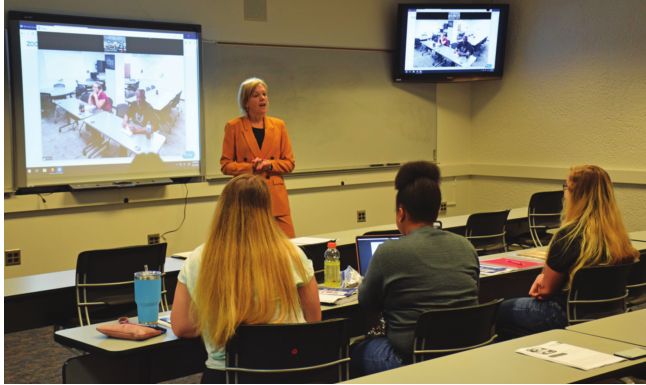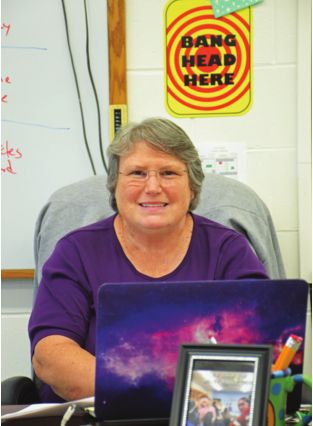Illinois goes to school on the teacher shortage
It appears that until very recently Illinois has been trying to make the career of teaching seem as unpalatable as possible.
“For many years there’s been a lack of respect for the educators in our schools,” said Kathi Griffin, president of the 135,000-member Illinois Education Association. “The funding has been diminished so much over the years that it’s not a welcoming profession for our students to entertain as a career.”
The lack of respect and funding, plus a number of other factors, have created what most in the education field are calling a “critical” teacher shortage in the state. The Illinois State Board of Education’s most recent annual public school vacancy survey conducted last October showed 1,407 unfilled classroom teaching positions in Illinois, with some school districts and subject areas disproportionately affected by the teacher shortage.
“The state’s rural areas find it difficult to supply classrooms with qualified educators,” said Illinois State Board of Education spokesperson Jaclyn Matthews. “Many superintendents and principals have noted they once had scores of applicants for teaching positions but now have just a few, or sometimes none.”
Recent legislative and public perception fixes are starting to turn things around, but relief from the current critical teacher shortage in the state may be a long time coming.
“This is not something that happened overnight, and it is not something that is going to be fixed in short order,” said Diane Hendren, director of governmental relations for the 2,000-member Illinois Association of School Administrators. “Superintendents are scurrying in many areas of the state trying to find teachers. You are seeing teachers moving from district to district because they are getting better offers.”
There are also not enough teacher candidates in the pipeline to fill those vacancies. The American Association of Colleges for Teacher Education reports that from 2010 to 2016 in Illinois, the number of people completing teacher preparation programs dropped by 53 percent.
Substitute teachers are also becoming more scarce.
“There is a shortage of substitute teachers, which generally happens during a good economy,” said Ben Schwarm,
deputy executive director of the 850-member Illinois Association of
School Boards. “When there are fewer jobs available, there tend to be
more applicants for substitute teacher jobs.”
Introduction to Teacher Shortage 101
The
roots of the current teacher shortage began with the 2001 No Child Left
Behind federal education initiative, according to Jennifer Hill, media
director for the 94,000-member Illinois Federation of Teachers. The law
brought an overemphasis on standardized testing, biased teacher
evaluation systems, larger class sizes, loss of professional autonomy
and reduced funding for teacher professional development, she said.
“On
top of that, Bruce Rauner’s term as governor made a tough situation
worse,” Hill said. “For those four years, teacher prep programs and MAP
grants for needy students were underfunded, which reduced the number of
students able to pursue higher education.”
Jennifer Martin is an assistant professor of Teacher Education at the University of Illinois Springfield.
“We
are now in a culture of ‘teach to the test,’ a heightened
standardization of curriculum and pressure to teach to the standardized
tests,” Martin said. “So young people are finding that learning in
school isn’t as much fun as it once was, so why would they want to work
in a place where they won’t have fun learning?
“Not
only do we have a teacher shortage, but we have a teacher-of-color
shortage,” Martin said. “The state’s required teacher test was a
gatekeeper that kept a lot of nontraditional students out of the
profession.”
Legislation
signed in August by Gov. J.B. Pritzker will do away with the test to
which Martin referred, but there’s still the issue of teacher autonomy.
“Teachers
wonder if they are being expected to teach kids basic life skills
rather than educate them,” said Springfield Education Association
president Aaron Graves. “They are disillusioned when they realize they
can’t do creative things with kids like Robin Williams did in Dead Poets Society.”
And
then there’s teacher pay, an issue that has also been addressed by
recently signed legislation. Sue Scherer was a teacher for 34 years in
the Decatur and Maroa-Forsyth school districts, and as 96 th District
state representative she voted for the bill that increased the minimum
teacher salary.
“It
goes back to so many years of low pay that there just isn’t the respect
for educators the way there used to be,” Scherer said.
Retirement Math 102
Illinois
teachers have been traditionally underpaid, at least early in their
careers, so they have often had to supplement their income with
secondary employment. But because of what they do for a living, teachers
and their spouses are penalized under Social Security rules.
“It’s
a very sore subject with our members,” said Illinois Teachers
Retirement System spokesman Dave Urbanek. “If they work two jobs, like a
lot of teachers do, and they pay Social Security on the second job,
they are not getting the full benefit of that work experience.”
Urbanek
said Illinois is one of 15 large states where teachers voted in the
1950s to opt out of Social Security through their primary employment,
choosing to use the Illinois Teachers Retirement System instead because
of its better benefit. But teachers still pay into Social Security with
each secondary job paycheck.
“If
somebody is a teacher for a certain amount of time but they’ve also got
Social Security credits, and their spouse has Social Security credits,
under federal law their Social Security payment is reduced,” Urbanek
said. “The federal government views it as double dipping.”
The
Illinois General Assembly added to newer teachers’ retirement concerns
when they established the “Tier 2” rules as part of state pension reform
in 2010. Tier 2 mandates that those who start teaching after 2011 must
wait until at least age 67 to retire with a full pension, up from 55
years of age for those who began teaching before that year. In addition,
teachers from 2011 onward must pay nine percent of their salary toward
retirement with a reduced benefit, compared to six percent for those
hired before 2011.
Intermediate Teacher Shortage 202
Fewer employees to do the same amount of work means more work per employee.
“Teachers
are overloaded with large class sizes, more classes to teach, a heavy
dependence on substitutes and educators forgoing contractual preparation
time in order to supervise and instruct students,” said Hill of the
Illinois Federation of Teachers. “They have less time to focus on
individual student needs.”
Lack
of preparation time and the use of substitute or temporary teachers to
help fill vacancies has taken its toll, according to the Springfield
Education Association’s Graves.
“That
creates a vacuum of professionalism where people are collaborating, and
when you don’t have those consistent relationships, it’s tough to have
that kind of consistency with kids,” Graves said. “And inconsistencies
with kids often create behavioral issues.”
Class
size is another consideration. The statewide average class size is 20,
according to the State Board of Education, but board spokesperson
Matthews said the teacher shortage disproportionately affects certain
regions and subjects.
Springfield
School District 186 has class size limits set forth contractually with
the Springfield Education Association, which are 31 students for
elementary and 33 students for middle and high school. Superintendent
Jennifer Gill said class sizes fluctuate across buildings and grade
levels, but the district’s average class size remains at 20.
District
186 employs approximately 1,150 certified staff and has 13 certificated
vacancies. Jacksonville School District 117 has 268 teachers, eight of
whom are long-term subs, and has 10 open teaching positions posted.
“We
are in a critical shortage,” said District 117 Superintendent Steve
Ptacek. “Positions that require a specialized certificate, such as
teachers, are more difficult to find.”
Mark Klaisner is the president of the 80-member Illinois Association of Regional Superintendents of Schools.
“As
I travel the state I hear about shortages everywhere,” Klaisner said.
“In our studies, 85 percent of superintendents reported the teacher
shortage as a significant problem in 2018, and I expect it to be even
worse this year.”
Introductory Compensation and Testing 201
On
Aug. 22 Gov. Pritzker signed legislation that establishes a minimum
starting teacher salary of $40,000, to be phased in between now and the
2023-24 school year. Former Gov. Bruce Rauner vetoed similar legislation
last year.
The
legislation’s sponsor, former teacher and current State Rep. Katie
Stuart, D-Edwardsville, said starting salaries for some Illinois
teachers are approximately $27,000, creating a challenge for school
districts to retain teachers. She said that any amounts school districts
pay toward the state teachers’ pension fund on behalf of full-time
educators will be counted toward the minimum salary requirement under
the new law.
The
average teacher salary for all experience levels in the 2017-18 school
year was $65,721, according to State Board of Education spokesperson
Matthews.
Superintendent
Gill said the legislation’s impact on Springfield District 186 will be
negligible, as their lowest-paid starting teachers now make $39,416,
including the district-paid retirement contribution. The district
already exceeds the limits for the 2019-20 through 2022-23 school years,
she added, and noted that the teacher retention rate at District 186 is
90 percent, exceeding the state average of 85 percent.
In
Jacksonville District 117, Superintendent Ptacek noted, “We raised the
teacher salary last year and it is making a difference in our ability to
find teachers. We have fewer open positions, but we are still in need.”
Many school districts, however, will find it tougher to meet the new salary requirements.
“An
arbitrary cookie-cutter approach across the state will be harmful,”
said the Illinois Association of School Boards’ Schwarm. “Districts just
aren’t going to have the money to pay for that and in some cases it
will actually result in fewer teachers.”
The Illinois Association of School Administrators’ Hendren echoed those sentiments.
“We
as an organization opposed that bill because of the cost to the school
districts,” Hendren said. “We don’t like salaries being set in statute,
but we understand the intent of the bill.”
The
Illinois Education Association’s Griffin pointed to school funding
reform legislation passed a year ago and said the law’s evidencebased
funding could help some districts with the cost of the minimum salary
increase.
Springfield
High School educator Cathy Turner, who has taught for 25 years and
started out at $15,000 per year, said the minimum salary legislation
leaves out one important consideration.
“It’s
not just the bottom end, but you’re insulting the people who are the
backbone of your school by if you don’t support your upper end,” Turner
said. “Money is going to be one of the issues that is always in play.”
Everyone
seems to agree on the benefits of a law signed Aug. 7 that does away
with the Basic Skills Test, a requirement that all teacher candidates
demonstrate complex skills, such as geometry proofs, that often were
unrelated to the grade or subject the candidate intended to teach.
”Doing
away with the test allows 246 individuals to either receive a
Professional Educator License or to move forward with other remaining
requirements,” the State Board of Education’s Matthews said. “It also
allows approximately 1,300 teaching candidates in Illinois to begin
student teaching immediately this fall without having to take a test of
basic skills.”
Matthews
said teaching candidates still must pass the edTPA, a performance-based
and subject-specific assessment, as well as the content test relevant
to the subject and grade they intend to teach.
“Making
changes to the basic skills test should be helpful, but you’re not
going to see that for two or three years as students get through the
programs,” said Schwarm of the Illinois Association of School Boards.
Jasmine McCray is in her fifth year of teaching at Wilcox Elementary School in Springfield.
She vividly remembers the tests she had to take a few years ago just to become an educator.
“During
undergrad work you had additional tests that you had to take and they
were really expensive, and if you didn’t pass you had to pay for it
again,” McCray said. “It was kind of hard to believe that there were so
many expenses for the program before you even graduated.”
Other
new laws sponsored by 48 th District State Senator Andy Manar, who has
been a legislative leader in education reform, include measures that
create incentives for teachers to work in rural and remote areas, making
it easier for educators outside of Illinois to apply for hard-to-fill
jobs here, and creating a short-term substitute teaching license and
allowing downstate retired teachers to substitute in classrooms without
jeopardizing their retirement benefits.
“We
have done much of what has to happen to address the shortage of
teachers in the state,” Manar said. “But I also believe there has to be a
societal change toward how teachers are viewed. We can’t legislate
that.”
Teaching the Teachers 204
Area colleges and universities are doing what they can to generate graduates who want to become teachers.
The
University of Illinois Springfield (UIS) has created a pathway to a
teaching degree for those who are currently working as paraprofessionals
in area schools, are a few courses shy of completing a degree, or who
are working as aides in the classroom.
“We
will start seeing people who would have been interested in being
teachers start thinking about the process again,” said UIS professor of
education Vickie Cook. “Those career changers have a huge amount of
expertise to add to the classroom. They may have had a business or
military career and now they are interested in coming back into the
classroom.”
The
university is also working with schools in Sangamon and Logan counties
to provide a dual credit program so high school students who want to be
teachers can take the first two classes toward a teacher education
degree at a reduced tuition cost. Cook added that UIS’ Prairie Area
Teaching Initiative is also being used to inspire first-generation and
minority students to enter the teaching profession.
Illinois
College in Jacksonville has seen a decrease in the number of students
interested in pursuing degrees in education over the past decade, but
that trend seems to be reversing and the school has made some changes to
accommodate it.
“This
year we have added two professors to our education department, one who
specializes in agriculture education and the other in literacy,” said
Illinois College spokesman Bryan Leonard. “We also have a new psychology
professor who specializes in math anxiety that will also be beneficial
to our education students.”
Continuing Education Reform 301
What else needs to be done to address the Illinois teacher shortage? Those previously quoted in this story weighed in.
Jennifer
Hill, media director, Illinois Federation of Teachers: “The state
should fund programs that increase opportunities for paraprofessionals,
parents and students to get teaching degrees and stay to work in the
community where they live.”
Diane
Hendren, director of governmental relations, Illinois Association of
School Administrators: “Restrictions have to be eased, even if it is
temporary. Teachers who have degrees in a content area but not a degree
in education, maybe they can teach some of these high school courses.”
Ben
Schwarm, deputy executive director, Illinois Association of School
Boards: “There are still some obstacles for those looking to cross state
lines and teach in our school systems, even though they were licensed
and had experience in their previous state.”
Jennifer
Martin, assistant professor of teacher education, University of
Illinois Springfield: “We need to defer student loans or forgive loans
for people who commit to work for several years in the more struggling
areas.”
Jasmine
McCray, Springfield elementary school teacher: “There need to be more
incentives going into the profession. Many teachers feel we are always
having to fight for something, and if there were more attention shown to
the positive things that teachers do, it could change the way that
people think of teachers as a whole.”
Introduction to Optimism 101
The
bipartisan Illinois Education Association State of Education poll
conducted in March 2019 showed that 88 percent of survey respondents had
a favorable opinion of teachers, but 57 percent felt that teachers were
not paid enough, and only 53 percent would encourage a family member to
seek a career in teaching. A total of 68 percent said improving public
schools is one of the most important issues facing Illinois.
“It’s
an extremely stressful job, but the reason people keep doing it is
because it’s also probably the most rewarding job on earth, because you
can truly make a difference,” said Sue Scherer, state representative and
former teacher.
Illinois
Education Association President Griffin sounded an optimistic note. “I
think maybe the ship is starting to turn a little bit more, that we’re
looking to enhance the quality of education in our public schools and
not focus on dismantling them,” Griffin said.
Springfield High School teacher Turner has been through a lot, but she’s never regretted her career choice.
“I
have had a fantastic career, it has been loads of fun, but it will soon
be time to pass it off to someone else,” Turner said. “And remember,
you are only a doctor or a lawyer or any other position in life because
of your teachers.”